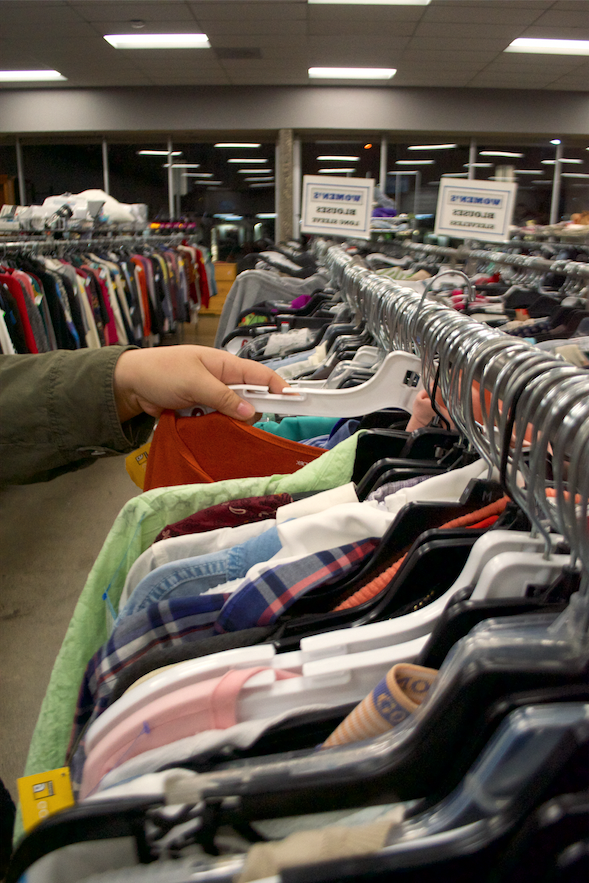Pop some tags
Thrift shopping serves as a cheaper alternative to conventional shopping
November 21, 2018
lthough she doesn’t go thrift shopping as often anymore, English teacher Hannah Gould has been buying items from thrift stores since she was in high school. She originally started to shop at these stores after taking inspiration from her dance teachers, who shopped there regularly. According to Gould, they were costume designers who had great senses of style and bought a majority of their clothes at thrift stores.
“They always just had these amazing outfits,” Gould said. “I was very impressed by their style and that was kind of the ethos of the dance studio, so I started going there as well, and I realized that there were just a ton of really cool things [that] were cheap.”
Senior Mia Yang also took inspiration to thrift from someone who she looks up to: her mom. Yang recalls spending hours at thrift stores with her mom when she was younger. However, recently, she started thrifting because her friends also found fashionable pieces of clothing at the stores.
Yang’s interest in thrifting was further intensified when she discovered Depop, a shopping app that allows shoppers to buy and sell different items, like clothing and makeup. This allowed her to make some money as well. Yang was even able to sell a jacket that she bought for $10 at a thrift store for $30.

“I had gone thrifting before, but I never went with the intention to sell—it was always looking for my own things,” Yang said. “But I went and I found a couple things that, although were really cool, I wouldn’t wear them, but based on what I saw was popular and easily sold on Depop, I would look for things like that and it worked really well.”
While both Yang and Gould started thrift shopping after being influenced from people in their lives, junior Sophia Powell started thrifting when she could no longer find items of clothing that appealed to her in conventional shops.
“It’s honestly a cheaper alternative to just buying clothes in general,” Powell said. “Although our mall is really big, and there’s a lot of stores, I didn’t necessarily find stuff that I really liked. So I found some really good thrift stores, and [was able to find] some stuff that I like.”
Powell generally shops more at thrift stores than conventional stores, explaining that she hasn’t gone to the mall in over a year to shop for clothes. In fact, she wears at least one or two thrifted items a day since a majority of her wardrobe consists of clothing she has found at thrift stores.
“I definitely lean towards thrifting more than just conventional shopping because obviously you save a lot more money,” Powell said. “I like to recycle my clothing too, so I will even donate my clothes.”
On the other hand, Yang finds more of a balance between buying clothes from traditional retail stores and thrift shops, as she has a different focus in each location.
“I definitely mix [thrift shopping] in with conventional shopping because when I go thrifting, it’s to find cool pieces or comfortable things, but if I go to the mall, usually I’m looking for something very specific or something very trendy,” Yang said.
Although Gould used to thrift shop for clothes more when she was younger, she still buys furniture and items for her home at thrift stores.
“More recently I’ve stopped buying as many clothes from there because now that I’m older, I feel like I need to get clothes that are a little more well made,” Gould said. “I still buy a lot of furniture and houseware stuff from [thrift stores] and a lot of that stuff is really amazing.”
Gould explains that the variety of items readily available in thrift stores is what constantly draws her to thrifting. The hodgepodge of items is intriguing to her as everything is different, random and more unique, since the items sold come from donations.
“There’s just a nice variety, but it’s not like a variety that is decided by some authority figure in fashion like you would find at a department store,” Gould said. “Someone didn’t decide what’s there. It’s just an authentic variety of what exists in the world. It’s just more interesting.”
While Gould finds the variety of items in the store appealing, Yang describes that there is something about reusing and recycling clothes that interests her.

“It’s always cool to me that I’m getting clothing that somebody else has worn because it has a history to it,” Yang said. “You don’t know who wore [it], where it came from, where it’s gone. So I think in that aspect, that’s pretty cool too.”
Despite this, Yang also acknowledges that this can be a downside and recommends washing anything purchased at a thrift store before wearing it.
“It’s cool that you don’t know where they came from, like they have a history, but you don’t know where they came from,” Yang said. “You don’t know who wore it so you definitely have to wash everything before you [wear] it because not only might it have been sitting [in the store] for a long time, but you don’t know where it’s been, who’s tried it on.”
Another downside to thrift shopping is that the items found may not be in great condition with holes or strange smells, according to Gould.
“Sometimes the clothes can be worn out. I’ve definitely bought things from thrift stores before that have holes in them or they seem fine at first, but then they start to fall apart quickly or maybe they don’t smell that great,” Gould said. “So sometimes you get that and you think it’s fine at first, and then you’re like, ‘Oh, actually, I don’t actually want to wear this anymore.’”
Regardless, Gould still finds thrifting to be valuable as it can help the environment since it is reusing and recycling clothing that has already been made.
“Instead of people deciding that they don’t want something, and then having it be put in the trash or just sitting in their closet, you’re recycling,” Gould said. “It’s fewer products being made, fewer waste, and they’re cheaper than clothes that you would typically buy in a regular store.”
Gould also enjoys the vintage aspect of clothes from thrift stores, since many pieces were in style during different eras of fashion.
“I always liked that your clothes are unique and you’re not wearing like the same thing that everyone else is,” Gould said. “It’s something that was made and was in in style, like 15 years ago, and now it’s fashionable again, and no one else has it.”
According to Yang, this also allows thrift shoppers to branch out of their style, finding and choosing styles that they may not normally buy at a conventional store.
“You’ll find vintage clothing or clothing they don’t make any more, like what I’m wearing now,” Yang said. “I think it was like a dancer’s leotard, not a shirt, but it was cool so I bought it. Clothing you normally wouldn’t buy otherwise, like I found ski pants to wear just normally because they were cute, but if I go shopping at the mall, I’m not going to think ‘Hey let me get a pair of ski pants.’”
Although unique, stylish clothing can be found at thrift stores, Yang, Powell and Gould all recommend going to thrift stores that are larger and have variety because sometimes you have to really sift through all the items in order to find something that you like and is in the right size. Because of this, Gould explains that if you want to go thrift shopping, you can’t be looking for something specific or have a lot of expectations for what you want to find.
“You need to go to look for things that are striking and interesting and your size,” Gould said. “But beyond that, if you have parameters, then you’re going to be disappointed.”
Since it does take a while to find clothes at a thrift store, Powell feels very fortunate whenever she finds something that stands out and that she likes.
“I feel lucky, extremely lucky. Especially if it’s like a clothing brand that I would normally shop at a conventional store,” Powell said. “A lot of stores are usually organized by t-shirts, pants, but sometimes like it’s not organized by color and size. So you really have to dig through, so once you find a really good piece, [one that] you’ve been waiting for, it feels really good.”



















